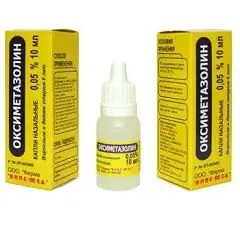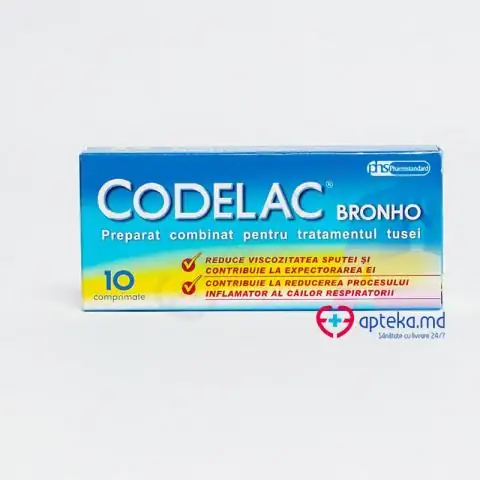Oxymetazoline
Oxymetazoline: instructions for use and reviews
- 1. Release form and composition
- 2. Pharmacological properties
- 3. Indications for use
- 4. Contraindications
- 5. Method of application and dosage
- 6. Side effects
- 7. Overdose
- 8. Special instructions
- 9. Application during pregnancy and lactation
- 10. Use in childhood
- 11. In case of impaired renal function
- 12. Drug interactions
- 13. Analogs
- 14. Terms and conditions of storage
- 15. Terms of dispensing from pharmacies
- 16. Reviews
- 17. Price in pharmacies
Latin name: Oxymetazoline
ATX code: S01GA04
Active ingredient: oxymetazoline (oxymetazoline)
Producer: Firm VIP-MED, LLC (Russia), Nanjing Tianlang Pharmaceuticals Co., Ltd. (China), Pharmstandard-Leksredstva, JSC (Russia), Pharmtechnology (Republic of Belarus)
Description and photo updated: 22.11.2018

Oxymetazoline is a drug used locally in ENT practice and has a vasoconstrictor effect; alpha adrenergic agonist.
Release form and composition
Oxymetazoline dosage forms:
- nasal spray 0.05%: colorless transparent liquid [10, 15 or 20 ml in a polyethylene bottle with a spray nozzle or a spray pump with a protective cap (for 10 ml); in a cardboard box 1 bottle];
- nasal drops 0.01%, 0.025% or 0.05%: slightly opalescent or transparent, colorless or pale yellow liquid (0.01% - 5 or 10 ml each, 0.025 and 0.05% - 5, 10, 15 or 20 ml in a polyethylene bottle with a hermetically sealed dropper stopper and a screw cap, in a cardboard box 1 bottle).
Composition of 1 ml spray:
- active substance: oxymetazoline hydrochloride - 0.5 mg;
- additional components: benzalkonium bromide, qs hydrochloric acid solution, sodium chloride, purified water.
Composition of 1 ml drops:
- active substance: oxymetazoline hydrochloride - 0.1; 0.25 or 0.5 mg;
- additional components: benzalkonium chloride, purified water, sodium hydroxide 0.1M; additionally depending on the manufacturer - sodium phosphate monobasic, sodium chloride, sodium phosphate disubstituted, Trilon B or disodium edetate dihydrate, sodium hydrogen phosphate dodecahydrate, sodium dihydrogen phosphate dihydrate.
Pharmacological properties
Pharmacodynamics
Oxymetazoline is a drug with vasoconstrictor (vasoconstrictor) and decongestant efficacy. When applied topically, the agent, stimulating alpha1-adrenergic receptors, leads to a narrowing of the vessels of the nasal mucosa, paranasal sinuses and the Eustachian tube, which leads to the elimination of their edema. Thanks to the action of the drug, nasal breathing is facilitated against the background of allergic and infectious-inflammatory rhinitis, and blood flow to the venous sinuses decreases. Oxymetazoline prevents bacterial complications, such as sinusitis, sinusitis, otitis media.
According to the results of clinical studies, the effect of the drug is noted already several minutes after administration and lasts up to 12 hours.
Pharmacokinetics
In the case of topical application of oxymetazoline, hydrochloride does not exhibit systemic action. With intranasal administration, the half-life is 35 hours or more. It is excreted in the urine of about 2.1% of the drug, and in the feces - 1.1%.
Indications for use
- acute respiratory diseases (ARI), accompanied by a runny nose (symptomatic therapy);
- allergic rhinitis;
- vasomotor rhinitis (for drops);
- rhinitis of an infectious and inflammatory nature (for spray);
- otitis media;
- eustachitis;
- sinusitis;
- hay fever.
According to the instructions, Oxymetazoline is also recommended for use to relieve edema before rhinoscopy or other manipulations in the nasal passages.
Contraindications
Absolute:
- angle-closure glaucoma;
- atrophic rhinitis;
- condition after transsphenoidal hypophysectomy;
- data in the anamnesis of surgical interventions on the dura mater;
- age up to 1 year - for drops of 0.025%;
- age up to 6 years - for drops of 0.05% and spray;
- combined use with monoamine oxidase (MAO) inhibitors, as well as a two-week period before and after the end of therapy with the latter;
- pregnancy - for drops, depending on the manufacturer;
- hypersensitivity to any of the constituents of the drug.
Relative (oxymetazoline is prescribed with extreme caution):
- diseases of the cardiovascular system: arterial hypertension, arrhythmias, chronic heart failure, tachycardia, coronary artery disease, severe atherosclerosis;
- chronic renal failure;
- increased intraocular pressure;
- diabetes;
- hyperthyroidism;
- pheochromocytoma;
- porphyria;
- hyperplasia of the prostate (urinary retention);
- pregnancy and the period of breastfeeding;
- combined use with tricyclic antidepressants, bromocriptine and other drugs that increase blood pressure (BP).
Instructions for the use of Oxymetazoline: method and dosage
Oxymetazoline is administered intranasally.
Nasal spray
Before each administration of the spray, the bottle must be shaken vigorously.
Children over 6 years old and adults are recommended to make 1 injection into each nasal passage at intervals of 10-12 hours. If the therapeutic effect in adults is insufficient, the frequency of use can be increased up to 3 times a day. Do not exceed the indicated dose.
Before using the bottle for the first time, it is necessary to calibrate it by pressing several times on the head of the spray nozzle or pump.
If you need a course over 5 days, you should consult your doctor.
Nasal drops
Recommended single doses and frequency of administration (per day), taking into account the patient's age and dosage of the drug:
- children under 1 year: 0.01% solution - from birth to the 5th week of life is prescribed 2-3 times or 1 time (depending on the manufacturer) 1 drop in each nasal passage; from the 5th week to 1 year - 2-3 times, 1-2 drops in each nasal passage;
- children from 1 year to 6 years: 0.025% solution - 2-3 times, 1-2 drops in each nasal passage;
- children over 6 years old and adults: 0.05% solution - 2-3 times, 1-2 drops in each nasal passage.
Do not use Oxymetazoline drops for more than 7 days.
Side effects
- cardiovascular system: infrequently - increased blood pressure, palpitations, tachycardia; extremely rare - arrhythmia;
- nervous system: rarely - headache, anxiety, fatigue (loss of energy, drowsiness), insomnia, hallucinations;
- respiratory system: often - burning / dryness of the nasal mucosa (transient), hypersecretion, sneezing, for a spray - dry mouth and throat; infrequently - reactive hyperemia (increased swelling of the nasal mucosa), epistaxis.
Undesirable reactions caused by the systemic action of oxymetazoline may include dizziness, sleep disturbances (in children), increased anxiety, irritability, itching, Quincke's edema, exanthema, nausea, visual impairment (in contact with the eyes), respiratory arrest (in infants), convulsions.
Against the background of long-term and continuous treatment with vasoconstrictor drugs, medication-induced rhinitis (recurrent edema of the nasal mucosa), tachyphylaxis, and atrophy of the nasal mucosa may occur.
Overdose
Overdose symptoms may include fever, vomiting, nausea, cyanosis, dilated pupils, mental disorders, shortness of breath, arterial hypertension, arrhythmia, tachycardia, cardiac arrest, pulmonary edema, depression of the central nervous system (lowering blood pressure, lowering body temperature, drowsiness, bradycardia, arrest breathing and coma).
Treatment in case of overdose is recommended to be symptomatic. In case of accidental oral administration of the drug, gastric lavage and activated charcoal are prescribed to evacuate the contents of the gastrointestinal tract, these measures should be carried out urgently since oxymetazoline is rapidly absorbed. If blood pressure drops, you cannot use selective alpha-blockers. If necessary, anticonvulsant, antipyretic drugs are administered and artificial ventilation is prescribed. Vasopressor drugs are contraindicated for use.
special instructions
Avoid getting oxymetazoline in your eyes.
Do not carry out continuous drug therapy for more than 7 days.
In the case of prolonged or frequent use of the product, the symptoms of nasal congestion may recur or worsen. When this effect appears, it is required to stop treatment and consult a specialist.
The nasal drops contain benzalkonium chloride, which can provoke swelling and irritation of the nasal mucosa.
Influence on the ability to drive vehicles and complex mechanisms
When using the spray and drops of Oxymetazoline in therapeutic doses, there was no negative effect on the ability to drive vehicles and control complex mechanisms. However, with a long course of treatment with high doses, the possibility of developing systemic adverse reactions of the drug cannot be excluded. In this case, it is necessary to exercise caution when performing work that requires special concentration of attention and speed of reactions.
Application during pregnancy and lactation
There are no clinical data confirming the safety of using the drug during pregnancy and lactation. As a result, Oxymetazoline in pregnant or breastfeeding women can only be used in extreme cases, when, in the opinion of the attending physician, the expected benefit from drug therapy to the mother significantly outweighs the possible risk to the fetus / child.
Pediatric use
It is contraindicated for children under 6 years old to use a spray and drops of 0.05%, for children under 1 year old - drops of 0.025%.
With impaired renal function
In the presence of chronic renal failure, it is recommended to use Oxymetazoline with extreme caution.
Drug interactions
- local anesthetic drugs: their absorption slows down and the effect is prolonged;
- MAO inhibitors (including 14 days before and after their use), other drugs that cause an increase in blood pressure: the risk of arterial hypertension is aggravated;
- tricyclic antidepressants: the threat of arrhythmia and hypertension increases;
- other vasoconstrictor drugs: the likelihood of adverse reactions increases.
Analogs
Oxymetazoline analogues are Afrin, Nazivin, Afrin extra, Nazol Advance, Nazivin Sensitiv, Nazo-spray, Vicks Active Sinex, Nazol, Nesopin, Otrivin, Noxprey, Rinostop Extra, Oxyfrin, Sialor.
Terms and conditions of storage
Store at a temperature of 0-25 ° C, out of the reach of children, protected from light.
The shelf life of the spray is 3 years, drops - 2 years.
Terms of dispensing from pharmacies
Available without a prescription.
Reviews about Oxymetazoline
According to most reviews, Oxymetazoline is an effective and inexpensive drug that helps adults and children quickly relieve nasal congestion and reduce swelling of the nasal mucosa. Patients confirm that nasal breathing is restored within 5-10 minutes after the introduction of drops or spray, and this effect lasts up to 10-12 hours.
The disadvantages of Oxymetazoline include adverse reactions, the most common of which are transient dryness and burning sensation that occur after its administration.
Price for Oxymetazoline in pharmacies
There is no reliable data on the price of Oxymetazoline, since the drug is currently not available for sale.

Anna Kozlova Medical journalist About the author
Education: Rostov State Medical University, specialty "General Medicine".
Information about the drug is generalized, provided for informational purposes only and does not replace the official instructions. Self-medication is hazardous to health!







